8 Great Native Cottage Garden Perennials Part I
April 19, 2009 by admin
Filed under Cottage Gardening
Welcome to the first in my “8 Great” series! Each “8 Great” list will present eight plants that have something in common that’s of interest to gardeners. They might be good for shade or late summer interest or a particular set of soil conditions—the common theme could be just about anything. I’m going to get the ball rolling with a list of eight perennials that are superb cottage garden performers and also happen to be native plants.
What qualities does a plant have to have to be a good choice for cottage gardens? The plants that have done best for me withstand crowding with aplomb, grow well in rich soil, and are resistant to fungal diseases.
It turns out to be a lot easier to pinpoint what makes a plant good for cottage gardens than what makes a plant “native.” If that seems strange to you, read the sidebar What Makes a Plant Native? and you’ll see why.
In these posts, I’m going to use the term “native” fairly broadly. In general, it means that the plant is thought to have been growing in eastern North America before 1600 or, in the case of a hybrid, that its parents were. I guarantee you’ve seen some of these plants growing in the wild hundreds of times. It should be no surprise that a lot of what we think of as “roadside plants” look beautiful when transplanted to the garden and given a little TLC. After all, every plant is a “roadside plant” somewhere!
 Bluestar
Bluestar
Amsonia tabernaemontana
Blooms May/June, pale blue flowers, 30-36″
 Butterfly weed
Butterfly weed
Asclepias tuberosa
Blooms June/July, brilliant orange flowers, 24″
 New England aster and New York aster
New England aster and New York aster
Aster novae-angliae * and A. novi-belgii *
Blooms August/September, many colors, 3-7′ depending on cultivar
 Purple coneflower
Purple coneflower
Echinacea purpurea
Blooms June/July, pinkish-purple flowers, 36″
 Oxeye sunflower
Oxeye sunflower
Heliopsis helianthoides
Blooms July/Aug, medium yellow flowers, to 48″+
 Bee balm
Bee balm
Monarda fistulosa, M. didyma and their hybrids *
Blooms late June/July and sporadically later on, many colors, 48″
 Meadow phlox or wild sweet William
Meadow phlox or wild sweet William
Phlox maculata *
Blooms July/Aug, pink or white and some bicolor flowers, 4-6′
 Culver’s root
Culver’s root
Veronicastrum virginicum
Blooms July/August, creamy white flowers, 6′
• Seek out mildew-resistant cultivars
Bloom times and other life cycle stats are accurate for northwest Connecticut. In milder areas all aspects of a plant’s life cycle may occur earlier in the year, and in colder areas, later.
What Makes a Plant “Native?”
Happily, people seem to be showing more of an interest in native plants than formerly, but they’re often surprised to learn how hard it is to define what “native” means. Native to Connecticut? New England? Eastern North America?And if you pin down that first part, then there’s a temporal problem. Native as of when? It’s easy to assume that we should use a date somewhere in the early 17th century, when European colonists began arriving in North America in numbers, but that would be somewhat arbitrary, in part because plants migrate slowly even without any help from people (colonists or Native Americans), changing their range over time in response to all sorts of environmental factors. In some cases, we don’t even know if a plant was growing in North America when the first colonists arrived or if it escaped from cultivation and became widespread before anyone thought to record the fact.
Native plant societies and state botanical societies are often the best resources for gardeners interested in exploring plants native to their state or small region.
Old Lyme, CT
April 4, 2009 by admin
Filed under Garden Lectures
Lecture: A Connecticut Cottage Garden: Adapting a Classic Garden Style to New England
Sunday, May 10-Mother’s Day; PRE-REGISTRATION REQUESTED
When: 2:00 PM
Where: Florence Griswold Museum, 96 Lyme St., Old Lyme, CT
Phone: (860) 434-5542
This is a special Mother’s Day lecture and light tea program
This is the next lecture I’ll be giving. To see a complete schedule of all my upcoming lectures, please click here.
Breathtaking Bluebells
April 3, 2009 by admin
Filed under Shade Gardening, Spring Bloomers, Spring Ephemerals
Virginia bluebells (Mertensia virginica) are nothing less than the royalty of spring ephemerals. Large, showy, and colorful, they put on one of the very best spectacles of any spring blooming plant, with all the rich costuming you’d expect in the court of a queen.
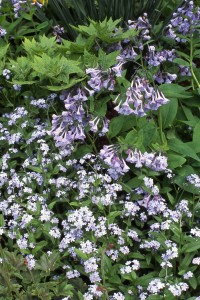
A May mêlée of Virginia bluebells and forget-me-nots
Virginia bluebells break ground very early in spring. Their tightly furled leaves look like tiny burgundy cabbages when they first emerge, but as they grow they quickly morph into medium green, fleshy oblongs that resemble the leafy green vegetable sorrel. Seemingly in no time they produce profuse clusters of dangling blue bell-shaped flowers on 18″ stems, blooming for several weeks in May. (They also come in a white-flowered form that is uncommon but possible to find.) Once flowering ceases, and almost before you have time to notice, they close up shop. Their leaves yellow rapidly, and the plants have gone completely dormant by mid June. They’ll spend the remainder of the year as inscrutable, seemingly dead but really just dormant roots nestled just below the soil surface. Incredibly, their entire aboveground life cycle is barely two months long.
The sheer rapidity of their growth and “demise” along with their large size and showiness make Virginia bluebells very border friendly. Their leaves do not need to hang around the garden for months to store enough energy to ensure flowering the following year. They put on their spectacular display and then vanish—a gardener’s dream!
Virginia bluebells are excellent interplanted with other blue-flowering plants such as perennial woodland phlox (Phlox divaricata). This phlox flowers just as the bluebells fade, so the segue from one to the other is seamless, and because the phlox spreads into a non-competitive groundcover, the bluebells will continue to arise through the mat of phlox foliage year after year. Biennial forget-me-not (Myosotis sylvatica) also makes a great companion, as shown in the photo above.
Virginia bluebells’ sky blue flowers are also an effective counterpoint to yellow daffodils. Gardeners with borders in both sun and shade can take best advantage of this artful duo, planting the sunny areas with clumps of daffodils and the shady ones with masses of bluebells. The result will be breathtaking!
Another natural companion is old-fashioned bleeding heart, whose brilliant pink or clean white flowers reach their peak simultaneously with those of Virginia bluebells, although the latter plant will go dormant months before the former. If you try this combination, use hostas, ferns or other late-emerging plants to fill in the areas occupied by the bluebells in May.
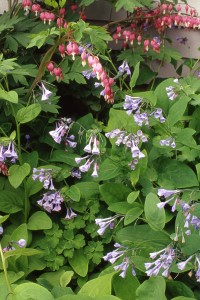
Bluebells and bleeding heart make a natural garden combination
Virginia bluebells spread readily by seed, moving outward from an original planting at a speed of a foot or two a year. In autumn, be careful working in the parts of your garden where bluebells are established, since it is so easy to dig into and accidentally destroy dormant roots at that time of year.
It’s not too late to have Virginia bluebells this year. Nurseries often stock them in April and early May since they’re one of the few plants that can be sold in full bloom at such a chilly time of year.
Sun/Shade needs: Half sun to moderately deep shade; full sun with adequate moisture
Hardiness: Zone 3
Size: 12-18″ tall; 8″ wide
Native status: Native to most of eastern North America, but not all of New England
Bloom times and other life cycle stats are accurate for northwest Connecticut. In milder areas all aspects of a plant’s life cycle may occur earlier in the year, and in colder areas, later.
March, 2010: Update! The good folks at GardenSMART took a shine to this article and reprinted it at their website. You’ll find this post (and many other interesting items) in the Articles section.
East Haven, CT
March 29, 2009 by admin
Filed under Garden Lectures
Lecture: A Connecticut Cottage Garden: Adapting a Classic Garden Style to New England
Saturday, April 4, 2009; PRE-REGISTRATION REQUESTED
When: 2:00 PM
Where: Hagaman Memorial Library, 227 Main St., East Haven, CT
Phone: (203) 468-3890
This is the next lecture I’ll be giving. To see a complete schedule of all my upcoming lectures, please click here.
Ridgefield, CT
March 28, 2009 by admin
Filed under Garden Lectures
Lecture: A Connecticut Cottage Garden: Adapting a Classic Garden Style to New England
Sunday, March 29, 2009
When: 2:00 PM
Where: Ridgefield Library, 472 Main St., Ridgefield, CT
Phone: (203) 438-2282
This is the next lecture I’ll be giving. To see a complete schedule of all my upcoming lectures, please click here.
Signs of Spring
March 25, 2009 by admin
Filed under Shade Gardening, Spring, Spring Bloomers, Techniques
At 7:44 AM on March 20 the Sun crossed the celestial equator heading north. In common parlance, that translates to: spring is here!
It didn’t take long for wildlife to answer the call. Two days later, I awoke to the sound of a red-breasted robin singing at 6:00 AM. The cardinals have been getting redder and redder and going great gangbusters for weeks with their impressions of distant car alarms, but they’re here year round. The robin was the first migrant I’d heard stretch its vocal cords this year.
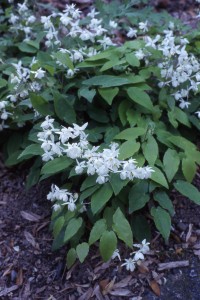
Epimedium x youngianum 'Niveum' in its April glory
While the robins celebrated spring by completing the last leg of their long journey, I was out in the garden performing one of the first jobs necessary to the season: uncovering my epimediums. (They have a common name—bishop’s hat—but somehow I just can’t bring myself to use it. They’ll always be epimediums to me.)
Along with hellebores and lungworts, epimediums start growing actively in March long before many of us have gotten out to remove the leaves that blew into the garden late last year after the rake had been put away for its long winter’s nap. (Or was it the gardener determined to nap? Tools can be convenient excuses…)
If you live on a lot with many trees, no matter how much you raked and blew last fall, you might find a lot of leaves staring up at you from the garden when the snow melts. Many plants can benefit from that cozy little coverlet, but for others it’s a problem.
While hellebores and lungworts are sturdy plants that can withstand the inevitable manhandling that occurs when you peel away sopping wet mats of oak leaves, epimediums are delicate little things with fragile stems all too easily snapped off. Wait even a week too long to clear them of leaf litter, and you may not be able to do it without surgical tools. (I exaggerate, but not by much.)
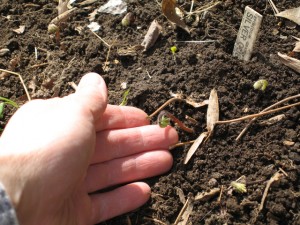
New epimedium growth under the leaf litter in March
At left is a picture of a curled epimedium flower stalk taken on March 20 just after being uncovered. This happens to be a patch of E. ‘Silver Queen’, a large-flowered white variety. In just a few weeks, it will put on a display to rival the extravagant bloomer E. x youngianum ‘Niveum’ shown in the picture above.
As careful as I tried to be when I removed the errant leaves, I wasn’t careful enough. Below left is a photograph of a stalk that I clumsily damaged. It takes almost no force to snap the top off these little guys, and that’s one spray of flowers less for me, the bees and everyone else this spring.
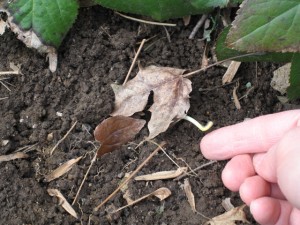
Epimedium stalk accidentally broken off
Some epimediums have fairly persistent stalks that don’t disintegrate on their own over winter. While you might not have to groom ‘Niveum’ at all, most others aren’t as accommodating. E. x perralchicum ‘Frohnleiten’ has perhaps the most evergreen leaves of any epimedium. This is both a plus and a minus. In snowless winters, they’re something to look at. But snow or no snow, in spring they’ll require cleanup. A pair of hedge clippers is the tool for this task. They do the job quickly and with all the precision required. You could just leave last year’s foliage alone, and new growth would come up through it and eventually conceal it, but most epimediums look better with a figurative shower and shave.
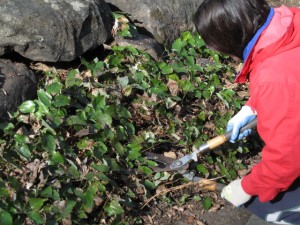
Shearing back epimediums in mid March
Unless you mulched last autumn, have some light, compost-based mulch handy to spread on your epimediums as soon as you uncover them. Otherwise, the soil around them will dry out quickly. At this time of year the sun is surprisingly intense, although most of us aren’t aware of it because air temperatures haven’t climbed yet. But I’ve learned that when I come out of my winter semi-hibernation and start working outdoors up to eight hours a day in March and April, I’d better wear sunscreen! New growth of shade-loving plants should also have some protection, not from the sun itself, but from the soil dryness it can cause.
Of course, even if I didn’t remove the leaves from my epimediums, they’d grow right up through their brown blanket and bloom anyway. But I prefer the look of a clean bed with a dressing of compost as a nice backdrop. Knowing that the job of removing those leaves without damaging the epimediums becomes harder with each passing day is enough incentive for me to get outside in mid March no matter what the weather. Ironically, as intolerant as they are of mishandling, fresh new epimedium growth will have no problem withstanding freezing nights.
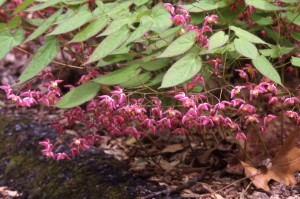
The reason for the work of the season. Darn—where'd that leaf come from?!
Collinsville, CT
March 23, 2009 by admin
Filed under Garden Lectures
Lecture: A Connecticut Cottage Garden: Adapting a Classic Garden Style to New England
Saturday, March 28, 2009; PRE-REGISTRATION REQUESTED
When: 2:00 PM
Where: Canton Public Library, 40 Dyer Ave., Collinsville, CT
Phone: (860) 693-5800
This is the next lecture I’ll be giving. To see a complete schedule of all my upcoming lectures, please click here.
Spring Blooming Shade Plants: Hellebores
March 18, 2009 by admin
Filed under Perennials, Shade Gardening, Spring Bloomers
In a typical year, hellebores will be the first ornamental perennial to bloom in the Northeast. Although there are several species that can be grown in this region, especially in milder areas such as the coast and the lower Connecticut River Valley, one of the hardiest remains my favorite: Helleborus x hybridus (formerly and sometimes still known as Helleborus x orientalis).
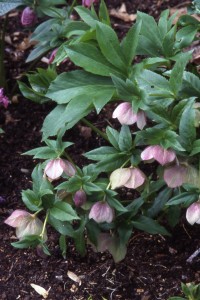
Helleborus x hybridus
Here in northwest Connecticut, hellebores send up their flower buds first, in March, before their leaves unfurl. As the month goes on, these succulent and tender looking shoots grow taller and taller, until they finally open up around April 1 to reveal clusters of 2″-wide, pendant blossoms. The species H. x hybridus is quite variable, with a range of subtle flower colors including creamy white, apple green, pale pink and burgundy. Its flowers often have striking speckled markings and prominent yellow anthers that are showy for about a week until the stamens fall off.
At first, hellebore flowers look a bit undressed because the plant’s leaves don’t come along until a few weeks later. When they do make their appearance, however, they are exceptionally attractive—leathery, glossy, palmate (arranged like fingers around the palm of a hand) and semi-evergreen.
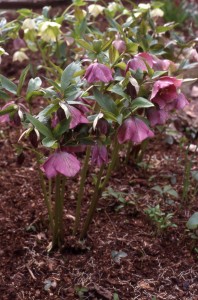
Hellebore flowers emerge before leaves
Everything about hellebores is long lasting. Instead of dropping off after 2-3 weeks, hellebore flowers slowly fade to a pale green or buff color in much the same way hydrangea flowers do. They look good (although subdued) right up to the point when the seeds mature and are dispersed, usually in the latter half of June. Deadhead them before that point unless you want seedlings the following spring. In most gardens, the leaves will remain disease free and unblemished all season long, and will still be looking good when the first snow flies.
Shade tolerance: High
Hardiness: Zone 5; other species may differ
Size: Medium sized, with a height and spread of 15-18″
Native status: non-native to any part of North America
Growing Tips
- Don’t cut back hellebore foliage in fall, even if you clean up the rest of your garden then. Why? Hellebores come up so early in the year, they are subject to damage from late frosts. These frosts won’t kill the plants, but they will kill the flower buds. As the plant’s shoots begin to emerge from the ground, last year’s leaves will provide some protection. After the new shoots have grown taller than last year’s leaves, you can groom them, cutting off the old foliage at ground level. Be careful not to accidentally cut off new growth—it’s easy to do. For a few more weeks after you groom them, it’s a good idea to keep some pine boughs or an equivalent handy to gently arrange over the new growth at night if a hard frost is in the forecast.
- Hellebores have to be several years old before they are mature enough to flower. A nursery plant in a 5-pint pot is probably only two years old, so don’t be surprised if it doesn’t flower its first (or even second) year in the ground. As long as the plant grows well and looks healthy, flowering should start when the plant is ready. A plant that fills a one-gallon pot should be old enough to flower its first spring after planting.
- H. x hybridus is often sold in a mix of undifferentiated colors. In other words, if the tag in the pot with your plant does not specify a flower color, but just says H. x hybridus, it could be any of the flower colors listed above. There’s no way to know which color you’ve got unless you buy the plant in bloom very early in the season and the plant is old enough to be blooming in the first place. In recent years, some growers have also offered hellebores in designated colors. I like the way the mixed colors look in the garden when hellebores are massed, but gardeners with color-theme gardens might prefer to purchase all of one kind.
- Hellebores have no special needs, but they don’t like excessive moisture. If put in exceedingly dank locations or planted in soils that drain poorly, rot of the crown may result.
- Hellebores self-sow moderately. Their seeds are large and heavy, so they don’t usually travel very far. If you don’t deadhead your plants before they drop their seeds, you’ll probably find a “skirt” of seedlings around their feet in spring. Move these to a nursery bed to mature or give them away to friends.
Bloom times and other life cycle stats are accurate for northwest Connecticut. In milder areas all aspects of a plant’s life cycle may occur earlier in the year, and in colder areas, later.
Captivating Cottage Gardens
March 18, 2009 by admin
Filed under Cottage Gardening, Garden Design
Cottage gardens possess an allure unmatched by any other kind of garden. Maybe it comes from being the horticultural equivalent of a woman with an hourglass figure, or maybe it’s just because they’re packed with such a variety of plant life that they’re never the same two weeks in a row, but whatever the source of their mystique, cottage gardens draw people like bees to nectar.
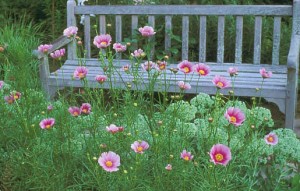
Cosmos takes center stage in a sweet cottage garden scene
This spring I’m giving a series of lectures about cottage gardening, focusing primarily on a very particular cottage garden I designed and built starting in 2000. At nine years of age, it’s had plenty of time to mature and evolve. Many good gardening lessons can be drawn from it, and I’ll be sharing them with you over the coming months.
If you’re in (or plan to be in) southern New England this spring, check out my lecture schedule to see if you can’t fit one into your plans. Most of them are free, and you can’t do better than that!
To get things started, I’ll just say a few words about what a cottage garden is. The origins of the cottage garden go back hundreds of years to a time when most people grew a significant amount of their own food and made a great deal of their own household products—from soaps and dyes to medicines—mostly from plants. Cottage gardens are named for the country cottages around which they were found. Although cottage gardens as a phenomenon certainly weren’t restricted to the British Isles, we did inherit the cottage gardening tradition primarily from the British by virtue of our shared history.
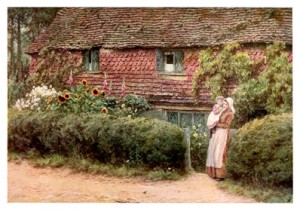
An artist's depiction of a traditional British cottage garden
Several things characterized the traditional cottage garden. It was on the small side, informal and not “designed” in anything like the modern sense of the word; it was a garden belonging to a person of modest means; it was a mix of flowers, vegetables and herbs (although the word “herb” meant something different then—more on that later); the plants in it were procured cheaply, usually in the form of passalong cuttings, divisions and seeds from friends and family; and it was densely packed with plants in order to maximize the productivity of a limited space.
Today’s cottage gardens are often strictly ornamental, vegetables and herbs now having their source at the local grocery store. They can be large, upscale and filled with the most fashionable of exotic vegetation, or they can be spaces where every resident plant carries an association with a loved friend or relative who gave it as a gift. Despite these differences, cottage gardens still look a lot like their ancestors—a testament to the adaptability of a loosely defined garden style. In fact, the only real requirements for a cottage garden are that it have a blowsy, freewheeling look and a lot of different flowering things.
That’s all for now—I hope you’ll join me over the coming months as we look in depth at how to make captivating cottage gardens.
Shelton, CT
March 8, 2009 by admin
Filed under Garden Lectures
Lecture: A Connecticut Cottage Garden: Adapting a Classic Garden Style to New England
Monday, March 23, 2009
When: 7:00 PM
Where: Plumb Memorial Library, 65 Wooster St., Shelton, CT
Phone: (203) 924-1580

